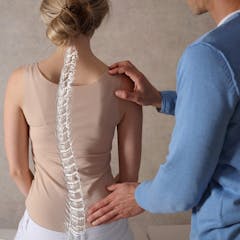
Articles on Back pain
Displaying 1 - 20 of 55 articles

Musk has recommended people experiencing severe neck and back pain should consider disc replacement surgery. Here’s what the research says.

The most common complaint among people with chronic pain is low back pain. Here’s what treatments do – and don’t – work.

A recent Four Corners episode questioned the use of surgically implanted devices called spinal cord stimulators for chronic back pain. Here’s what the evidence says.

The most important thing when it comes to spine health is movement.

Back pain is common. One in thirteen people have it right now and worldwide a staggering 619 million people will have it this year. Chronic pain, of which back pain is the most common, is the world’s most…

Scoliosis is a treatable condition, but only if detected early. Greater awareness of the condition and its dynamics will greatly aid in patient care moving forward.

An intriguing therapy that shifts what people perceive as the source of their pain could aid in pain management.

A new therapy aims to undo some of the harmful and restrictive patterns patients have been taught to ‘protect’ their back from pain. Instead, they’re learning to trust and move their body again.

The prevalence of low back pain continues to surge worldwide, but many treatments currently available offer little to no relief.

Opioids are the one of the most prescribed pain-relief for people with low back and neck pain. But new research shows they don’t effectively relieve low back or neck pain and can result in worse pain.

Our new study demonstrates the enormous potential that machine learning has to help identify people with AS

The science behind why crossing your legs while sitting could be detrimental to your health.

Most people sleep on their side, which is good because those who sleep on their backs are more likely to be poor sleepers or have breathing difficulties at night.

We’ve all been told our whole lives we need ‘good’ posture: sit up straight, stand straight with shoulders back, and lift by bending the knees. It turns out there’s really no evidence for that advice.

Researchers are still trying to figure out exactly what happens within muscle to create knots, also known as myofascial trigger points. But they do know some ways you can avoid or alleviate them.

Failure to look after your hip flexors can lead to injury, walking problems, posture issues and back pain.

If the pandemic made your back feel more sore than usual, moving more everyday may be important to help improve it.

Some people with back pain see immediate benefits from stretching.

Working from home in the long run could be better for your health, or it could also be worse. It depends on how your employer supports you.

Poor desk posture is pretty similar to the posture astronauts naturally adopt during spaceflight.
